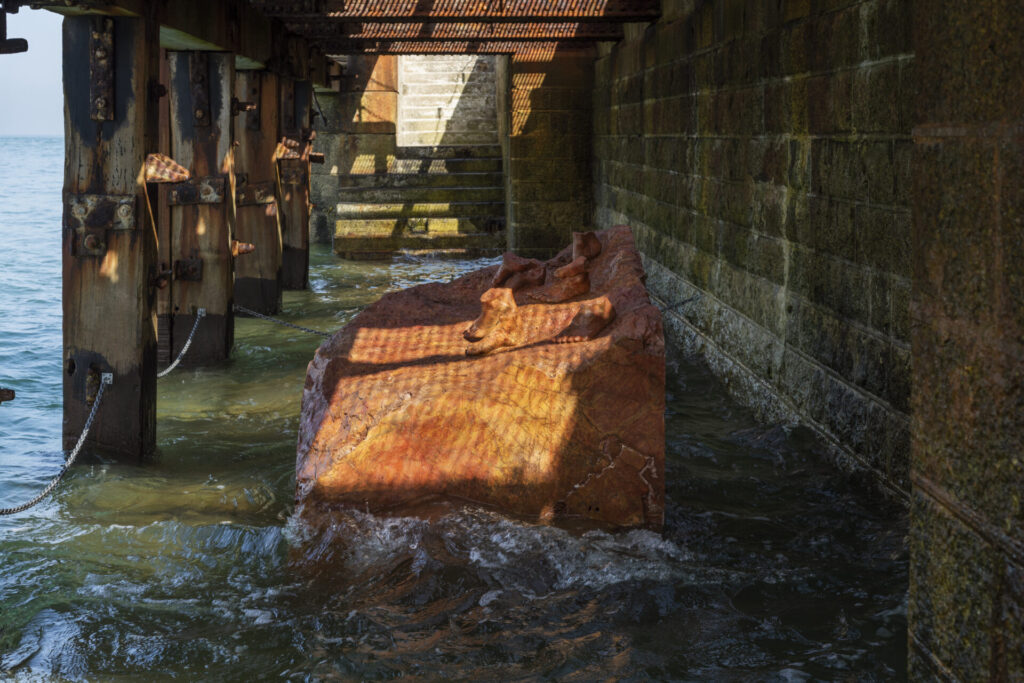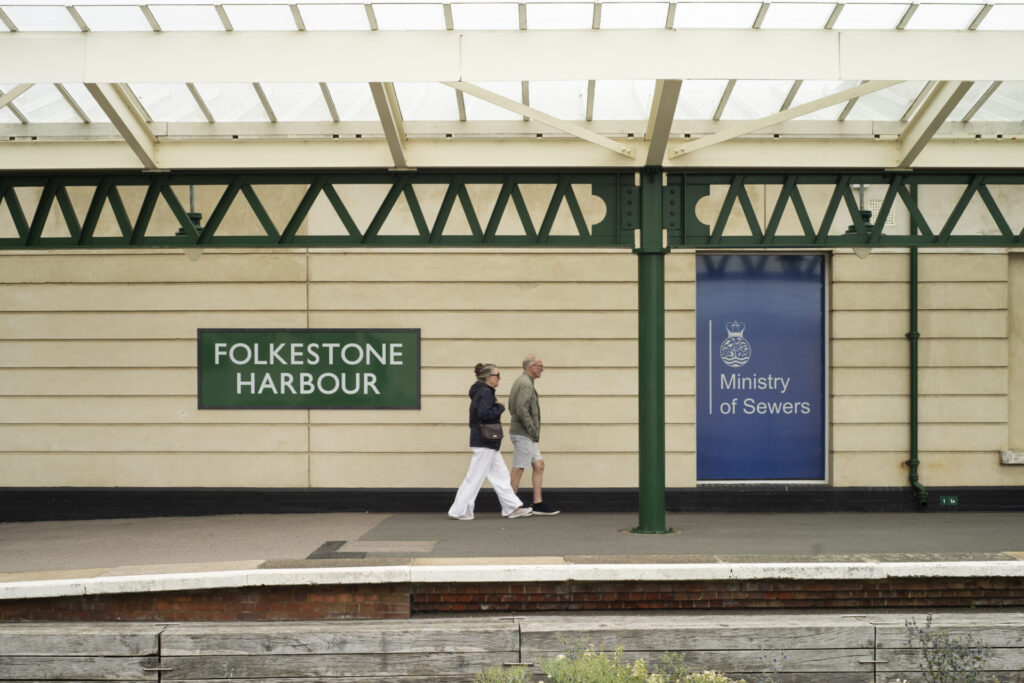The Open Golf Championship and the Portrush crowd in Antrim gasp in astonishment after Rory McIlroy hits his second shot at the par 4 11th. Bizarrely, he’s unearthed a hidden second ball that pops up like a benign bounding mine. What lies under the ground beneath our feet in this Weird British Isles of ours, this and its palimpsest of histories, its deep time, is the major curatorial concern in this stimulating new iteration of the Folkestone Triennial.
First up at the railway station we’re presented with a map work (J Maizlish Mole’s Folkestone in Ruins, 2025)) that sees the artist splicing information from the town’s history (circa AD 725–1925) with his own observations from a month-long residency. He notes traces of triumph and trauma. We see where seventy-two people died in a German air raid back in 1917 next to a record shop and a mural from an earlier triennial (Folkestone Lightbulb, 2017) by Michael Craig-Martin. The Channel itself is relabelled as The Gallic Sea in a neat contemporary critique of Trump’s ludicrous renaming of the Gulf of Mexico.
The map reappears down on the coast itself at the now defunct Folkestone Harbour station, repurposed today with trendy bars and restaurants. Nearby a building bearing a neoclassical portico acts as some form of government office: more underground business, a powerful work by Cooking Sections called Ministry of Sewers (2025). Here the public, the local community, can resist and report evidence of corporate negligence by documenting raw sewage leaks. A fountain – a bust of Margaret Thatcher (also defunct) drinking from a glass of water – humorously reminds us of who’s to blame for the debacle that is the privatisation of our drainage.
Nearby, under the old railway platform, the sea lapping at its base, is another work with insistent political import: Dorothy Cross’s sculpture, Red Erratic (2021). An enormous (seven and a half tonne) chunk of ginger-red marble – another unearthed object – quarried from Syria, sees several feet carved on the top of the block. The term ‘erratic’ refers to the geological phenomenon of rock displacement by glaciation. The work pithily points to human displacement and Syria’s ongoing refugee crisis.

Elsewhere we’re reminded how humans compound our own problems with the erratic displacements of other forms of mineral, namely radioactive waste, specifically Lithuania’s Ignalina nuclear power plant, as featured in Emilija Škarnulytė’s scary video, Burial (2022). What to do with all this carcinogenic stuff? We see the costly decommissioning in progress, an ultra-cautious demolition of the facility, the reactor tube tops due to be dismantled by 2038. The graphite containing carbon-14 has a half-life of 5,700 years and its chlorine-36 a mere 300,000 years. We hear the grinders, see the sparks fly, like witnessing the ultimate performance of auto-destructive art by Einstürzende Neubauten.
Chiming with Neubauten’s love for site-specific work, fellow Berliner Emeka Ogboh has a sound installation using song and the susurrations of the Channel as it washes in and out of a small concrete tunnel by the shore. Ode to the Channel (lyrics by Ogboh, music by Rachel Gerrard) is sung acapella by locals and refers to the birth of the Channel itself, its creation after a mega-flood. As with his brilliant albums, Ogboh continues to surprise by enhancing the experience of the song via a sour beer he’s created called Doggaland – a play on the submerged Doggerland under the North Sea – and an accompanying salty ice-cream he calls Coastal Drift (all works, 2025).
Another successful sound work is Hanna Tuulikki’s Love (Warbler Remix) (2025). Taking the birdsong of the Marsh Warbler as it migrates from South Africa to the UK, we see maps of its journey combined with a soundtrack that melds the ever-mutating tunes of the Warbler. Amazingly this clever creature cops licks from other birds, an avian sampler if you like. Tuulikki matches the calls with human love songs from the twenty-seven countries on the bird’s route, amongst others we hear Albanian and Lebanese voices, Ethiopian and Tanzanian. This in turn is also mixed in with live birdsong recorded at the old WW2 Sound Mirrors in nearby Dungeness. Imagine Holger Czukay making a hybrid of Messiaen and Steve Reich. Very pleasing.
Ghost Feed (2025) by the de-capitalized john gerrard stays with animals. An obelisk shape, not dissimilar to that seen in Kubrick’s 2001: A Space Odyssey (1968), sits on an abandoned set of rail tracks near the old station. This monolith bears a nightmarish computer-generated simulation that sees a white-cheeked spider monkey scrolling pathetically on a found smartphone. In the background the land is aflame, the forests burn. Inspired in part by Samuel Beckett’s Ghost Trio (1977) the work is deliberately upsetting, a sober reminder of the mess we’ve made of this world.

And what of other objects from our collective pasts? Those analogous to Rory’s occult golf ball (now resurrected to our general amazement) feature in Katie Paterson’s Afterlife (2025). Set in a spruced up Joycean Martello tower overlooking the town there’s a stylish circular wooden table with small hollows, each containing tiny amulets, protective mascots, around 200 or so, from various cultures. Each is remade with materials gathered from lost environments or those at risk – the originals might get nicked! We’re talking bits of dying coral reefs, microplastics from Mount Everest, and space junk now reformed into tiny whale tails, mouse netsuke, Thor’s hammer. As with William Faulkner the message is the past is never dead, it’s not even past.
We all, as per Dobie Gray/Bryan Ferry, end up in with the in-crowd. ‘In’ as in under the ground. Sara Trillo’s Urn Field (2025) meditates on death and final things. A set of chalk and clay cob sculptures lie dispersed in a fecund undergrowth of blackberry, mugwort and ragwort bushes. You think of Thomas Browne and the melancholy of burial, Sebald’s Rings of Saturn, the chalk of the white cliffs themselves, the fragments of billions of coccoliths, skeletons. The ground, the planet, as one giant ossuary. But, Beckettian bleakness’s aside, the Folkestone Triennial is a lot of fun. Expertly curated by Sorcha Carey the event combines the educational hit gained from extensive research with a treasure hunt enthusiasm. Go where the in-crowd go.
Folkestone Triennial takes places from the 19 July to the 19 October 2025


